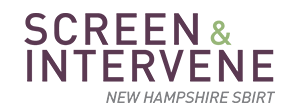Screening Tool(s)
OVERVIEW
Screening provides a means to identify the level of a patient’s use behavior, from no/low risk to risky use. Screening responses provide an opportunity for a discussion about substance use as part of the healthcare visit (see Brief Intervention). Screening enables identification of patients who are likely to benefit from a brief intervention, and distinguishes them from patients who are more likely in need of a referral. Conducting a screening is not making a diagnosis. Screening should be standardized and universal for the chosen population using an evidence-based tool.
This initiative recommends using the S2BI screening tool (Appendix H). The S2BI is best used as the initial screening tool. If a youth is identified as being at risk on the S2BI, the provider can use the CRAFFT Version 2.0 (Appendix I) screening questions to prompt further conversation and assessment. The Center’s recommendations for screening adult and/or pregnant populations are included in the Annotated Bibliography in Appendix V.
| Purpose of Play 5 | To identify the target population(s) and evidence-based screening tool(s) to be utilized in S·BI·RT implementation. |
| Definitions | Screening for potential health problems is standard in primary care. The addition of screening for alcohol and drug misuse and other potential behavioral health conditions strengthens the patient-centered approach to care. The screening process may reveal one of three possible results, explained further below:
No current use (youth), and/or low risk use (adults): This is a “negative screen” because the patient answers “No” to the initial screening questions. For example, “no current use” on the CRAFFT 2.0 is an answer of “No” to all of the three questions on Part A. Similarly, on the S2BI, an answer of “No” to all of the three questions indicates no current use. “No current use” does not mean there is no potential risk; only that there is no current use at the time of the screening. It is important to provide positive reinforcement for no current use for these youth. For patients aged 21+, alcohol use may be indicated but low risk and therefore positive reinforcement with no further action is indicated. At risk: Some current use indicates “at risk” in adolescents and the need for a Brief Intervention (See Play 6). This is considered a “positive screen.” Each tool has an “at risk” threshold. For example, “at risk” on the CRAFFT 2.0 is a “Yes” to any of the three questions on Part A. On the S2BI, answering “once or twice” on any of the questions indicates risk but no apparent substance use disorder. However, answering “monthly” indicates a possible mild or moderate substance use disorder. High risk: A positive screen of “at risk” should be followed by further questions to determine if the level of risk warrants a referral for evaluation and diagnosis. Again, each tool has a threshold for sufficient high risk to need a referral. On the CRAFFT 2.0, this threshold is a “Yes” to two or more of the questions on Part B. On the S2BI, answering “weekly” to any of the second set of four questions indicates a substance use disorder severe enough to warrant treatment. It’s important to remember that a provider can and should initiative a referral for evaluation at any time. Doing so is warranted based on the provider’s clinical judgement and knowledge of the patient and family. |
| Team members | Primary care practitioners and integrated behavioral health clinicians play crucial roles in determining the screening tool to be utilized. |
| Measure(s) |
|
Recommended Approach
- Review recommended screening tools.
- Explore what tools may already be built/available for your Electronic Health Record (EHR) and, therefore, potentially available at a reduced cost in a shorter time frame.
- Discuss potential pros/cons of suggested screening tool(s) such as length and information gathered.
- Screen electronically if flow and resources can accommodate (particularly appropriate for adolescent and young adult populations).
- If not electronically, screen on paper. Be sure to account for staff time required to input information into EHR and maintain confidentiality with hard copies.
- If deciding to screen verbally, ensure that the chosen tool has an evidence base for verbal administration and that the questions are asked exactly as written. Consider cost of staff/provider time for administration and regular booster training to maintain efficacy.
- Training in screening administration is imperative to receive consistent quality results.
- This Play recommends implementing screens currently utilized in NH health systems to encourage consistency; however, any evidence-based screen is an appropriate tool. We strongly recommend screening for both alcohol and drug use.
Keep In Mind
- Consultation and training on tools is available through the Center.
- Screening should be written or electronic.
- Screening tools have an evidence-base that is valid and reliable for the specific population and method of administration.
- Confidentiality considerations must be incorporated into every step of the screening process. Does your space provide for patient privacy when completing the screen? Where is the screening information saved in the EHR? If screens are administered by paper, how will you dispose of the screen? How is the screen incorporated into the record?
- S·BI·RT is an approach used across populations. Screening tools and information for adult and pregnant patients are available in the CDC’s Planning and Implementing Screening and Brief Intervention for Risky Alcohol Use: A Step-by-Step Guide for Primary Care Practices.
- Sites across NH are integrating alcohol and other drug screening into integrated screening tools with tobacco, depression, and anxiety.
Corresponding Appendix Section(s)
Appendix H – S2BI Screening Tool
Appendix I – CRAFFT 2.0 Screening Tool
